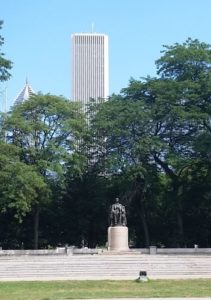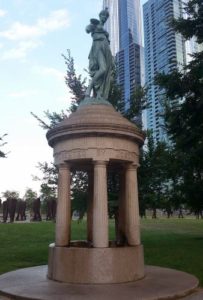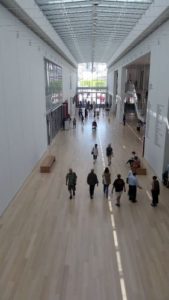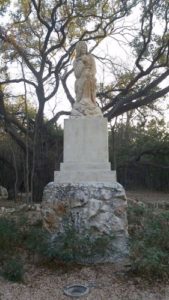I think this will end up being three parts. Next up, Grant Park and the Art Institute of Chicago.
On our first full day in Chicago, we walked to the Museum Campus up the Lake Shore Drive side of Grant Park and then back down the Michigan Avenue side after dinner (actually, we hadn’t planned to revisit Grant Park, but more on that when I do my blow-by-blow account of the actual trip).
First we passed the Seated Lincoln statue:

I thought about cropping this so that we’re closer to Lincoln, but I like the AON Center (formerly known as the Standard Oil Building) and Two Prudential Plaza so much that I left it this way. This is cropped, however. The original photo was taken from so far away that you can see the pillars on either side of the statue.
I took a picture of the Chicago skyline from near Buckingham Fountain (my favorite photo of which is on my Tumblr), but I cannot find a good way to post it without weird diagonal lines on Mid-Continental Plaza. I’ll continue working on this problem. Or maybe I’ll just give up.
Anyway, on our way back through Grant Park, I got a picture of what may be the oldest piece of public art in the park, the Joseph Rosenberg Fountain. Rosenberg got his start as a newsboy and was never (or seldom, at least) able to find someone willing to give him a drink. So in his will, he left money to the city to put a fountain where people could get free water. The fountain still works, but the water is non-potable.

Another photograph that I’m wrestling with was of The Bowman, one of the two statues of Native Americans on horses that stand at Michigan Avenue and Congress Parkway. It was getting pretty late by the time we walked through Grant Park and the picture is pretty badly backlit. It is, however, the closest I’ve ever been to either statue, so I’d like to share it once I get the kinks worked out.
One of the first places we visited (just after the Marshall Field & Co. Building, the Chicago Cultural Center, and Millennium Park) was the Art Institute of Chicago.
I’ve been going to the Art Institute of Chicago for decades. When I was 14 or so, my parents joined the museum, giving us basically unlimited visits for free, so we could just kind of arrive whenever and leave whenever without a lot of pressure to “get our money’s worth.” So, while I was a little rusty on this visit, I once pretty much knew the museum like the back of my hand.
Ever since I was very, very little, I’ve had memories of my parents and me in a museum that had art and also had a spiral staircase with a large window behind it. I seem to recall that there was a statue of a mushroom in the center of the staircase. I thought for years that it was a very odd dream until we visited for the first time in years, when I was about ten or so, and I found the staircase. I still have no idea about the mushroom.
Anyhow, here’s the staircase:

I took a lot of pictures of some of my favorite, and some of the most notable, artworks in the museum’s collections, but those are mostly for my own amusement and for me to look back at them and go, “I remember that trip.” American Gothic had been removed from its customary location in favor of being in a special exhibition on art in the Great Depression, which cost extra money. I saw it through the exit door of the exhibition and took a picture, just for the entertainment value. I’m playing around with it in Paint.Net and if I ever get something usable, I’ll let you know.
I took some more pictures of the museum itself, including this one of the new Modern Wing:

And this one of the reconstructed trading room of the Chicago Stock Exchange:

This may be the final installment or, as I said above, there may be one more. I need to go through my pictures from our final day in Chicago and see if I got any good pictures of Lincoln Park that were of the park itself and not of Lincoln Park Zoo. It was really, really warm that day and we were meeting a friend for lunch, so we didn’t have a whole lot of time to explore Lincoln Park. It was pretty much visit the zoo, take pictures of the lake, and then get on the bus and get to our lunch meeting.
One way or another, we’ll be back in Chicago on or about October 1, I think. If not then, then October 5 for certain. Probably.



